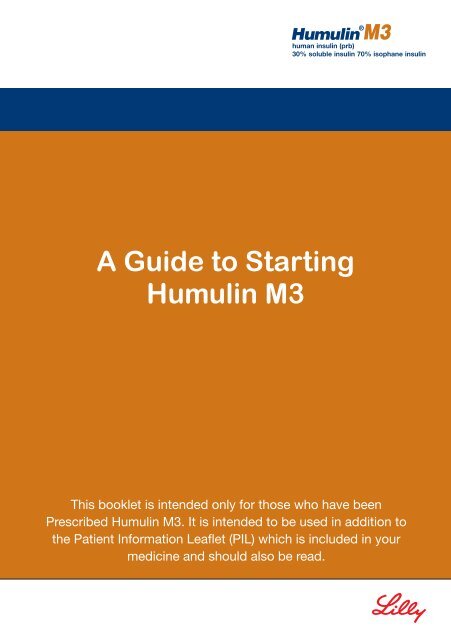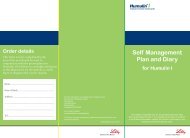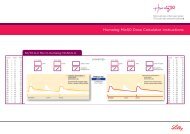A Guide to Starting Humulin M3 - LillyPro
A Guide to Starting Humulin M3 - LillyPro
A Guide to Starting Humulin M3 - LillyPro
You also want an ePaper? Increase the reach of your titles
YUMPU automatically turns print PDFs into web optimized ePapers that Google loves.
human insulin (prb)<br />
30% soluble insulin 70% isophane insulin<br />
A <strong>Guide</strong> <strong>to</strong> <strong>Starting</strong><br />
<strong>Humulin</strong> <strong>M3</strong><br />
This booklet is intended only for those who have been<br />
Prescribed <strong>Humulin</strong> <strong>M3</strong>. It is intended <strong>to</strong> be used in addition <strong>to</strong><br />
the Patient Information Leaflet (PIL) which is included in your<br />
medicine and should also be read.
Contents<br />
• What should I have from the pharmacist<br />
• Why have I been given this booklet<br />
• What is <strong>Humulin</strong> <strong>M3</strong> and how does it work<br />
• When do I take <strong>Humulin</strong> <strong>M3</strong><br />
• Who decides how much <strong>Humulin</strong> <strong>M3</strong> I need<br />
• When do I check my blood glucose levels<br />
• Instruction for self adjustment of my insulin<br />
• How do I inject my <strong>Humulin</strong> <strong>M3</strong><br />
• What if I forget an injection<br />
• What is a hypo and why does it happen<br />
• How do I deal with hypos<br />
• What should I do if I feel unwell
What should I have from the pharmacist<br />
Cartridge<br />
KwikPen<br />
Vial<br />
You have been prescibed an insulin called <strong>Humulin</strong> <strong>M3</strong>.<br />
Ensure that your medicine has <strong>Humulin</strong> <strong>M3</strong> on the<br />
packaging, as shown above<br />
Your insulin should be - please tick<br />
• 3ml <strong>Humulin</strong> <strong>M3</strong> cartridge for use in a<br />
reusable pen device e.g the HumaPen Savvio<br />
• 3ml <strong>Humulin</strong> <strong>M3</strong> KwikPen (prefilled)<br />
• 10ml <strong>Humulin</strong> <strong>M3</strong> vial (for use with a syringe)<br />
❑<br />
❑<br />
❑
Why have I been given this booklet<br />
You have been prescribed <strong>Humulin</strong> <strong>M3</strong> (your insulin),<br />
<strong>to</strong> help you manage your diabetes.<br />
The aim of this booklet is <strong>to</strong> allow you <strong>to</strong> learn more<br />
about your insulin and help you make the right<br />
decisions about adjusting your insulin, and taking<br />
control of your diabetes.<br />
It is intended <strong>to</strong> be used in addition <strong>to</strong> the Patient<br />
Information Leaflet provided with your medicine.
What is <strong>Humulin</strong> <strong>M3</strong> & how does it work<br />
<strong>Humulin</strong> <strong>M3</strong> is made from a combination of two types<br />
of insulin:<br />
• 30% Soluble Insulin (short acting)<br />
• 70% Isophane Insulin (intermediate acting)<br />
Putting <strong>to</strong>gether a short acting insulin and an<br />
intermediate acting insulin produces a quick rise<br />
in insulin activity after injection, which gradually<br />
subsides over time.<br />
This is how the <strong>Humulin</strong> <strong>M3</strong> works over a 24 hour period.<br />
24 hour action profile<br />
Breakfast<br />
Injection<br />
Lunch<br />
Evening<br />
Injection<br />
approx 30 min<br />
before breakfast<br />
approx 30 mins<br />
before meal<br />
Theoretical representation of <strong>Humulin</strong> <strong>M3</strong> insulin activity profile<br />
twice per day<br />
Expected insulin production during the day in people without diabetes<br />
Time of injection - approx 30 minutes before meal
When do I take <strong>Humulin</strong> <strong>M3</strong><br />
This insulin should usually be taken about 30 minutes<br />
before breakfast and about 30 minutes before your<br />
evening meal.<br />
You may be advised <strong>to</strong> take it more or less frequently;<br />
this will be decided between you and your healthcare<br />
professional.<br />
How much will I need<br />
Please complete:<br />
approx. 30 mins<br />
before breakfast<br />
approx. 30 mins<br />
before evening<br />
meal<br />
Dose<br />
This is your starting dose and may increase.<br />
Your dose may need <strong>to</strong> change based on your blood<br />
glucose readings.
Who decides how much<br />
<strong>Humulin</strong> <strong>M3</strong> I will need<br />
Your insulin dose will be adjusted by yourself and/or<br />
your healthcare professional according <strong>to</strong> the blood<br />
glucose tests you do.<br />
Do not worry if it takes a while before you reach<br />
your target blood glucose levels and you need more<br />
insulin. Each person is different and what is important<br />
is that it is the right amount for you.<br />
Why do I need <strong>to</strong> test my blood glucose levels<br />
It is important that you are aware of your own blood<br />
glucose levels in order for you <strong>to</strong> take the appropriate<br />
action, for example, adjusting your insulin dose.<br />
There are a number of reasons why you may need <strong>to</strong><br />
adjust your insulin dose, including:<br />
• High blood glucose levels (hyperglycaemia)<br />
• Low blood glucose levels (hypoglycaemia)<br />
• Stress/illness
When do I check my<br />
blood glucose levels<br />
To test the effect of your insulin, the recommended<br />
blood glucose tests are pre-meals and pre-bed.<br />
Your healthcare professional will discuss with you<br />
how often <strong>to</strong> test.<br />
What should your blood glucose levels be<br />
Please complete:<br />
Your pre-breakfast<br />
............... mmol/L<br />
Your pre-lunch<br />
Your pre-evening meal<br />
Your pre-bed<br />
............... mmol/L<br />
............... mmol/L<br />
............... mmol/L<br />
It may take a while <strong>to</strong> achieve these levels and you<br />
may require an increase of your insulin.<br />
Do I need <strong>to</strong> adjust my insulin and how do I do it<br />
You might not need <strong>to</strong> adjust your insulin. If you<br />
do need <strong>to</strong> adjust your insulin your healthcare<br />
professional will talk you through the next few steps.<br />
You may feel apprehensive at first, but it is important<br />
that you take control <strong>to</strong> make it work for you.
Instruction for self-adjustment<br />
of my insulin<br />
When testing your blood glucose, if you have<br />
consistently high readings for more than three days<br />
at any testing point, then you will need <strong>to</strong> adjust<br />
your insulin.<br />
Your healthcare professional will explain <strong>to</strong> you how<br />
<strong>to</strong> adjust your insulin and will complete the following<br />
table for you needs.<br />
<strong>Humulin</strong><br />
<strong>M3</strong> twice<br />
daily<br />
Before<br />
Breakfast<br />
Before Lunch<br />
Before<br />
Evening<br />
Meal<br />
Before Bed<br />
Above Below Above Below Above Below Above Below<br />
Adjust<br />
dose<br />
Adjust Evening<br />
dose<br />
Adjust Morning dose<br />
Adjust Evening<br />
dose<br />
Dose reduction is recommended if any results are<br />
consistently less than 4 mmol/L at any time.
How do I inject my <strong>Humulin</strong> <strong>M3</strong><br />
Your healthcare professional will explain how <strong>to</strong><br />
inject your insulin. Injection is usually via approved<br />
pen devices or insulin syringe.<br />
Where do I inject<br />
Your insulin can be injected in the places shown<br />
below. The site of the injection should be rotated<br />
within the chosen area <strong>to</strong> prevent complications<br />
developing at your injection site and aid absorption.<br />
Check with your healthcare professional for suitability<br />
of injection sites.
Preparing your injection<br />
It is important that before you inject your insulin you<br />
rotate it between the palms of the hands ten times and<br />
invert it through 180° ten times immediately before use.<br />
This is <strong>to</strong> ensure the insulin is mixed properly. It should<br />
appear uniformly cloudy or milky.<br />
The image above is a KwikPen, if you have been<br />
prescribed <strong>Humulin</strong> <strong>M3</strong> in a cartridge you should load<br />
the cartridge in<strong>to</strong> the pen device and then mix similarly<br />
<strong>to</strong> that shown above.
What if I forget an injection<br />
Forgetting your insulin is rarely an emergency<br />
situation. Seek advice from your diabetes team.<br />
The advice will vary depending on when you have<br />
realised you have forgotten <strong>to</strong> take your insulin<br />
What if I cannot remember if I had my insulin<br />
If you are in any doubt, do not take again. In both<br />
cases your blood glucose may run a little higher after<br />
the injection you have forgotten. Do not worry.<br />
It is very important that you<br />
know the name of your Pen device,<br />
your insulin and the name<br />
of your blood glucose meter<br />
My insulin is:<br />
My pen is:<br />
My blood glucose meter is:
What is a hypo and why does it happen<br />
A blood glucose reading of 4 mmol/L and under is<br />
hypoglyceamia (a hypo). A hypo occurs when blood<br />
glucose falls <strong>to</strong>o low. People feel different things<br />
when a hypo is starting, you may also find some of<br />
your hypos feel different from others.<br />
A hypo can happen for a number of reasons;<br />
• If you’ve missed a meal or had one later than usual<br />
• If you’ve not had enough food or eaten less food<br />
than normal<br />
• If you’ve had more insulin than necessary<br />
• If you’ve been more active than usual<br />
• If you’ve been drinking alcohol<br />
• If you’ve experienced extremes in temperature,<br />
either hot or cold<br />
If your diabetes is well controlled occasional hypos<br />
are a normal part of life for people with diabetes, but<br />
they shouldn’t take over your life. If you are having<br />
frequent hypos, speak with your diabetes team.
Hypos begin quickly, but there are usually warning<br />
signs. Symp<strong>to</strong>ms can vary from person <strong>to</strong> person,<br />
but may include the following:<br />
• Sweating<br />
• Thumping heart<br />
• Looking pale<br />
• Weakness or tiredness<br />
• Pins and needles sensation<br />
• Dizziness/ feeling tipsy, drunk<br />
• Disturbed vision<br />
• Mild confusion<br />
• Slurred speech<br />
• Hunger<br />
• Aggression or altered behaviour<br />
• Headache<br />
If hypoglycaemia isn’t corrected it can lead <strong>to</strong> more<br />
serious conditions such as loss of consciousness.
How do I deal with hypos<br />
If you experience a hypo, you should deal with it by<br />
taking 15-20g of quick acting carbohydrate such as:<br />
• 5 - 7 Dextrosol ® tablets or,<br />
• 90-120 ml of original Lucozade ® or,<br />
• 100-200 ml of pure fruit juice such as orange juice<br />
Your healthcare professional may also advise you of<br />
quick acting carbohydrate such as:<br />
It is advisable <strong>to</strong> re-check your blood glucose level <strong>to</strong><br />
ensure your blood glucose levels are rising.
If you are not about <strong>to</strong> eat a meal, ensure you eat<br />
10-20 grams of slow acting carbohydrate, <strong>to</strong> maintain<br />
your blood glucose levels until you next eat.<br />
This can be:<br />
• half a sandwich<br />
• fruit<br />
• a small bowl of cereal<br />
• biscuits and milk<br />
Your healthcare professional may also advise you of<br />
slow acting carbohydrate such as:<br />
The exact quantity will vary from person <strong>to</strong> person<br />
Remember <strong>to</strong> carry your identity card and glucose<br />
tablets with you in case of an emergency.<br />
If you have regular hypos consider adjusting your<br />
insulin and/or contacting your nurse or doc<strong>to</strong>r.
What should I do if I feel unwell<br />
A number of common illnesses can cause your blood<br />
glucose <strong>to</strong> rise. When you are unwell you may not<br />
want <strong>to</strong> eat or take your insulin treatment as normal,<br />
but it is important <strong>to</strong> follow these basic rules:<br />
1. Keep on taking your insulin<br />
However ill you feel and however little food you are<br />
eating, you may still need insulin. Sometimes in these<br />
circumstances you need more than your usual dose.<br />
Ask your healthcare professional for specific advice<br />
on what action <strong>to</strong> take when you are ill.<br />
2. Moni<strong>to</strong>r your blood glucose<br />
Moni<strong>to</strong>r your blood glucose. Test at least 4 times<br />
daily as your blood glucose levels will indicate<br />
whether you require extra insulin doses.<br />
3. Take carbohydrates in liquid form<br />
Take unsweetened fluids if your blood glucose is<br />
high. If you still do not feel like eating as your blood<br />
glucose returns <strong>to</strong> normal then substitute food with<br />
sweetened fruit juices or drinks that contain glucose.
Notes Page
Notes Page
Side effects should be reported.<br />
This includes any possible side effects not listed in<br />
the package leaflet. If you experience side effects talk<br />
<strong>to</strong> your doc<strong>to</strong>r or other healthcare professional.<br />
Any side effects from your medication can be reported at<br />
www.mhra.gov.uk/yellowcard.<br />
Side effects and product complaints can also be<br />
reported <strong>to</strong> Lilly: please call Lilly UK on 01256 315 000.<br />
By reporting side effects you can help provide more<br />
information on the safety of medicines.<br />
Eli Lilly & Company Ltd<br />
Priestley Road<br />
Basings<strong>to</strong>ke<br />
RG24 9NL<br />
01256 315 000<br />
www.lillydiabetes.co.uk/patients<br />
This booklet has been developed with the Diabetes Specialist Nurses in Sheffield and<br />
Mid-Yorks NHS Trust and funded by Lilly as a service <strong>to</strong> patient care.<br />
The booklet has been reviewed for medical accuracy and printed by Lilly.<br />
UKHML00057c(1) March 2014











![Humalog Mix50 (50% insulin lispro [rDNA origin] injection ... - LillyPro](https://img.yumpu.com/44269187/1/184x260/humalog-mix50-50-insulin-lispro-rdna-origin-injection-lillypro.jpg?quality=85)

![Humalog Mix25 (25% insulin lispro [rDNA origin] injection 75 ...](https://img.yumpu.com/35487335/1/184x260/humalog-mix25-25-insulin-lispro-rdna-origin-injection-75-.jpg?quality=85)


